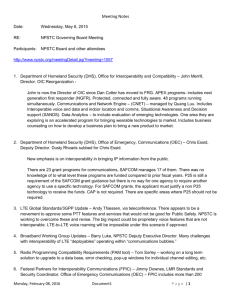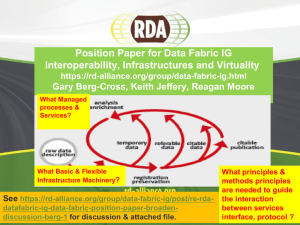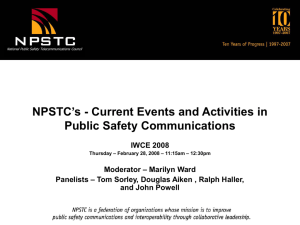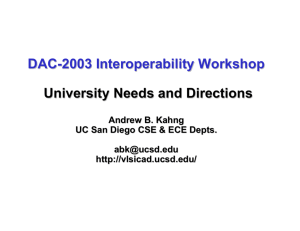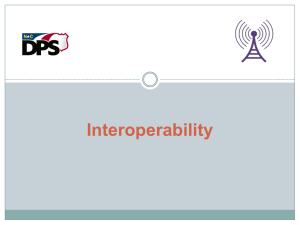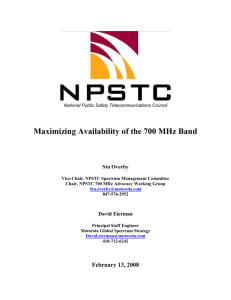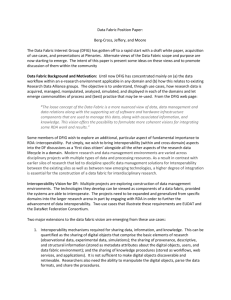NPSTC APCO Panel Presentation
advertisement
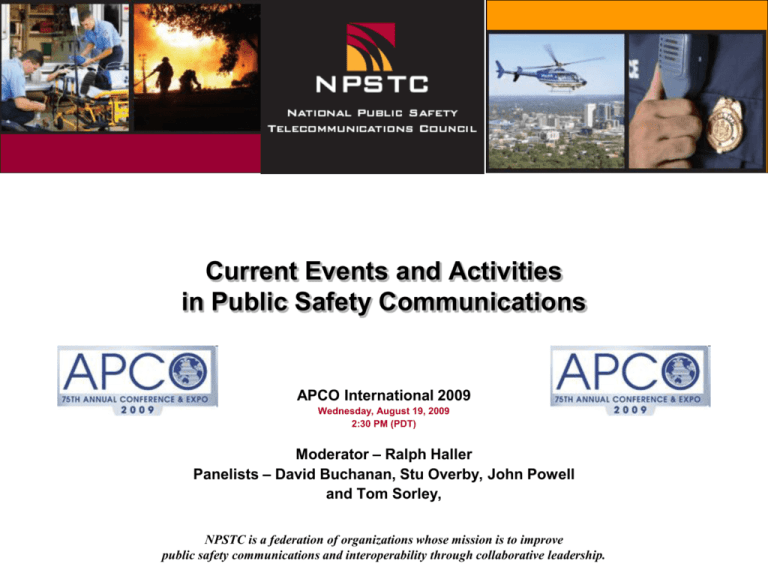
Current Events and Activities in Public Safety Communications APCO International 2009 Wednesday, August 19, 2009 2:30 PM (PDT) Moderator – Ralph Haller Panelists – David Buchanan, Stu Overby, John Powell and Tom Sorley, NPSTC is a federation of organizations whose mission is to improve public safety communications and interoperability through collaborative leadership. NPSTC Mission Statement NPSTC is a federation of organizations whose mission is to improve public safety communications and interoperability through collaborative leadership. NPSTC is a federation of organizations whose mission is to improve public safety communications and interoperability through collaborative leadership. 2 NPSTC Member Organizations Member Organizations: Associate Organizations: • • • • • • • • • • • • • • • • • American Association of State Highway and Transportation Officials American Radio Relay League Association of Fish and Wildlife Agencies Association of Public-Safety Communications Officials – International Forestry Conservation Communications Association International Association of Chiefs of Police International Association of Emergency Managers International Association of Fire Chiefs International Municipal Signal Association National Association of State Chief Information Officers National Association of State Emergency Medical Services Officials National Association of State Foresters National Association of State Telecommunications Directors National Emergency Number Association National Sheriffs’ Association Canadian Interoperability Technology Interest Group Telecommunications Industry Association Liaison Organizations: • • • • • • • • • Federal Communications Commission Federal Emergency Management Agency Federal Partnership for Interoperable Communications National Telecommunications and Information Administration Office of Emergency Communications Office of Interoperability & Compatibility SAFECOM U.S. Department of Interior Department of Justice • NIJ COMMTECH NPSTC is a federation of organizations whose mission is to improve public safety communications and interoperability through collaborative leadership. 3 How is NPSTC organized? • NPSTC Governing Board – Representatives from each of its member organizations • Executive Committee – The Executive Committee comprises of the NPSTC Chair, Vice Chair, the four Committee Chairs and Committee Vice Chairs • Four Operational Committees – Interoperability Committee – Outreach Committee – Spectrum Management Committee – Technology Committee NPSTC is a federation of organizations whose mission is to improve public safety communications and interoperability through collaborative leadership. 4 NPSTC Organization Liaison Organizations FCC, FEMA, FPIC, NTIA, OEC, OIC, SAFECOM, US DOI, US DOJ - NIJ COMMTECH Interoperability Committee Governing Board Organizations Associate Organizations AASHTO, AFWA, ARRL, APCO, FCCA, IACP, IAEM, IAFC, IMSA, NASCIO, NASEMSO, NASF, NASTD, NENA, NSA CITIG, TIA Spectrum Management Committee Technology Committee Monitoring Topics: Monitoring Topic: COML, NECP, Plain Language, Project 25, Project Mesa 800 MHz Rebanding, National Planning Assistance & Coordination (NPAC), 4.9 GHz, and Narrowbanding Below 512 MHz Monitoring Topics: Border Issues Outreach Committee Editorial Review National Interoperability Information eXchange (NIIX) New Technologies Broadband 470-512 MHz Channel Naming In-Building Coverage Participant Development 700 MHz Emergency Medical Services Public Safety Spectrum Requirements Website Review Airborne Video ESF-2 Technology Education Software Defined Radio Wireless Alerting NPSTC is a federation of organizations whose mission is to improve public safety communications and interoperability through collaborative leadership. 5 700 MHz Broadband Network Requirements Task Force David Buchanan NPSTC is a federation of organizations whose mission is to improve public safety communications and interoperability through collaborative leadership. 6 Broadband Task Force Purpose • Develop recommendations on the minimum elements required for a 700 MHz Broadband National Interoperability Framework • Help ensure interoperability and roaming across all systems deployed • NOT redefine the Statement of Requirements (SoR) issued previously on November 13, 2007 NPSTC is a federation of organizations whose mission is to improve public safety communications and interoperability through collaborative leadership. 7 Broadband Task Force Organization 700 MHz Broad Band Task Force Chair: David Buchanan dbuchanan@deloitte.com Technical Group Chair: Andy Thiessen andrew@its.bldrdoc.gov Co-Chair: Emil Olbrich Operational Group Chair: Dan Hawkins dan.hawkins@search.org Vice Chair: Dave Troup Governance Group Chair: Laura Phillips laura.phillips@sfgov.org Co-Chair: Bill Schrier NPSTC is a federation of organizations whose mission is to improve public safety communications and interoperability through collaborative leadership. 8 Operations Work Group • Goal: Develop recommendations for the minimum set of applications required to support intrasystem roaming and interoperability on a nationwide basis NPSTC is a federation of organizations whose mission is to improve public safety communications and interoperability through collaborative leadership. 9 Technical Work Group • Goal: Using LTE as the selected technology standard and input from the Operations and Governance Work Group develop recommendations for the Regional System configurations to support roaming and interoperability NPSTC is a federation of organizations whose mission is to improve public safety communications and interoperability through collaborative leadership. 10 Governance Work Group • Goal: Develop recommendations for template agreements between the Regional System operators and the PSST. This Work Group will also make other recommendations necessary from a governance viewpoint to support roaming and interoperability NPSTC is a federation of organizations whose mission is to improve public safety communications and interoperability through collaborative leadership. 11 Work Group Meetings • Most of the BBTF work is accomplished via conference calls and email • Two in person meetings were held – the first at Boulder CO at the NIST Facility and the other here at the APCO conference • The Work Group each had weekly conference calls resulting in some folks attending 4 separate calls each week. • The process was open and transparent to all persons wishing to participate • Thanks goes to APCO and NIST for their support hosting the in person meetings NPSTC is a federation of organizations whose mission is to improve public safety communications and interoperability through collaborative leadership. 12 Operational Findings (Draft) • Required – 8 – – – – – – – – Internet access Home VPN access Local home/sign-in page (status) SMS/MMS Messaging Subscriber unit location LMR gateway Responder access to ICS Ambulance roaming • Desired – 4 – – – – One-to-many LMR Voice PSTN Voice Field based applications NPSTC is a federation of organizations whose mission is to improve public safety communications and interoperability through collaborative leadership. 13 Technical Findings (Draft) • Required – 6 – Device: 700 MHz based on 3GPP LTE technology • Minimal interface support including security – Device must scan band segments, select cell, authenticate • Handover between systems based on roaming agreements – System assigns IP address to subscriber – Capability to share information with roaming network and device – Roaming to other PS 700 networks or commercial networks – System of common system and subscriber unit identifiers needed • Options being considered based on international standards • Probably administered by PSBL NPSTC is a federation of organizations whose mission is to improve public safety communications and interoperability through collaborative leadership. 14 Governance Findings (Draft) • FCC issues rules for local/regional buildout and issues waivers in the interim • FCC allows PSLB to sublicense local/regional entities • Congress/FCC reallocates D-Block to public safety • Congress/FCC allows local/regional public/private partnerships • Congress/FCC allows network access to first responders, critical infrastructure, federal, and others as defined by regional network administrators • PSBL should convene local/regional user advisory group NPSTC is a federation of organizations whose mission is to improve public safety communications and interoperability through collaborative leadership. 15 Questions? NPSTC is a federation of organizations whose mission is to improve public safety communications and interoperability through collaborative leadership. 16 Influencing Spectrum Regulations Stu Overby NPSTC is a federation of organizations whose mission is to improve public safety communications and interoperability through collaborative leadership. 17 Overview • • • • • U.S. DTV Transition FCC Broadband Notice of Inquiry (NOI) Expansion of 470-512 MHz Operation Amendment of 4.9 GHz FCC Rules Public Safety Alerting in 900 MHz Two-way Paging Spectrum NPSTC is a federation of organizations whose mission is to improve public safety communications and interoperability through collaborative leadership. 18 U.S. DTV Transition • As of June 12, 2009 the 700 MHz Band is cleared of full power TV stations nationwide • Low Power TV stations, TV translators and wireless microphones still in band are secondary to public safety use • NPSTC is actively influencing the process to address these secondary operations NPSTC is a federation of organizations whose mission is to improve public safety communications and interoperability through collaborative leadership. 19 Digital Replacement Translators MB Docket 08-253 • As part of DTV transition, FCC proposed rules for Digital Replacement TV Translators 12/23/08 • NPSTC filed comments 1/12/09: Do not allow digital replacement translators in the 700 MHz band or within interference range of 470-512 MHz LMR systems • FCC issued decision 5/8/09: – Digital Replacement translators allowed only outside 700 MHz – “Per NPSTC's recommendation, we clarify that replacement translator stations are subject to the interference protections to land mobile station operations in the 470- 512 MHz band set forth in the rules.” NPSTC is a federation of organizations whose mission is to improve public safety communications and interoperability through collaborative leadership. 20 700 MHz LPTV and Wireless Mics • DTV Transition Legislation does not clear Low Power TV or Wireless Microphones • Agencies planning deployment should notify LPTV stations. See http://www.npstc.org/lowPowerTV.jsp • FCC has an open rulemaking to address wireless microphones (WT 08-166): NPSTC Letter to FCC FCC Issues Order and NPRM Comments and Replies Due Jun. 2008 Aug. 2008 Oct. 2008 Several DTV Follow-up Letters Filed Transition Ended Seeking Action Feb. & March 2009 NPSTC is a federation of organizations whose mission is to improve public safety communications and interoperability through collaborative leadership. June 12 2009 FCC Action Expected By Y/E 2009 21 FCC Broadband Notice of Inquiry (NOI) GN Docket No. 09-51 • FCC must provide report to Congress by February 2010 • Inquiry very broad; key focus is broadband for the public; some Public Safety questions included • NPSTC Reply Comments filed 7/21/09: – Foundational elements of public safety requirements – Some regions require own networks; others need 3rd party partner – Adequacy of “off the shelf” solutions relate to system design, not just the technology – Agencies need to select own interoperable devices & applications – Benefits of satellite backup – Need for public safety interoperability cross-border – Role of 4.9 GHz for localized broadband and backhaul NPSTC is a federation of organizations whose mission is to improve public safety communications and interoperability through collaborative leadership. 22 NPSTC 470-512 MHz Petition for Rulemaking RM-11527 • NPSTC filed petition in February 2009 to expand area where 470-512 MHz can be used – – – – Expand from 50 miles to 80 miles in current 11 markets Treat Baltimore as separate market from DC Use less conservative co-channel protection ratios Allow engineering studies for shortspacing LMR to TV • FCC placed petition on public notice with comments due May 7; reply comments due May 22 • Comments filed all generally supportive • Next step: Discussions with FCC re issuing NPSTC a follow-up Notice of Proposed Rulemaking NPSTC is a federation of organizations whose mission is to improve public safety communications and interoperability through collaborative leadership. 23 4.9 GHz Band WP Docket 07-100 • FCC revised 4.9 GHz rules to raise the status of fixed stations used for broadband from secondary to primary status • Companion Further NPRM issued proposing to apply Part 101 coordination procedures to fixed operations • NPSTC filed Comments July 20, 2009: – 4.9 GHz band has mix of mobile, point-to-point and point-tomultipoint stations – Part 101 coordination procedures not a good fit – Recommended that regional planning committees implement registration procedures instead NPSTC is a federation of organizations whose mission is to improve public safety communications and interoperability through collaborative leadership. 24 Public Safety Wireless Alerting • 901-902, 930-931-940-941 MHz commercial spectrum auctioned in 1993 for “narrowband PCS” known as two-way paging in the industry • Spectrum is currently licensed but has low usage • On December 12, 2006, FCC granted the City of Richmond a waiver to use one channel at 23 sites. • NPSTC has draft Petition for Rulemaking in process to seek some channels for public safety alerting use across the country NPSTC is a federation of organizations whose mission is to improve public safety communications and interoperability through collaborative leadership. 25 Questions? NPSTC is a federation of organizations whose mission is to improve public safety communications and interoperability through collaborative leadership. 26 PSWAC Identified Spectrum Needs Tom Sorley NPSTC is a federation of organizations whose mission is to improve public safety communications and interoperability through collaborative leadership. 27 Future Public Safety Spectrum Needs Working Group • Update Spectrum Requirements Identified in the 1996 PSWAC Report • Assess Current Technology and Spectrum Usage • Investigate Technologies Available over the 2010 – 2020 Timeframe • Use Modeling Tools to Update Spectrum Requirements (Similar to PSWAC Process) NPSTC is a federation of organizations whose mission is to improve public safety communications and interoperability through collaborative leadership. 28 PSWAC Identified Spectrum Needs • 25 MHz of new spectrum for voice and data within 5 years; targets 700 MHz band as source • 24 MHz allocated in 700 MHz • 2.5 MHz of spectrum in VHF/UHF bands (138-512) for interoperability • No action taken • Public Safety sharing of 1710-1755 MHz federal band – 12 Narrowband Voice – 12 Broadband – 2 Guard band • Spectrum allocated for commercial use and auctioned for AWS NPSTC is a federation of organizations whose mission is to improve public safety communications and interoperability through collaborative leadership. 29 PSWAC Identified Spectrum Needs • Allocate 4635-4685 MHz band for Public Safety • The allocation of 5850-5925 MHz for ITS should be finalized • NTIA substituted 4940-4990 MHz and FCC allocated to Public Safety • FCC finalized the allocation • No Action Taken • Increase sharing for Public Safety users on unused TV channels below 512 MHz – NPSTC Petition February 2009 NPSTC is a federation of organizations whose mission is to improve public safety communications and interoperability through collaborative leadership. 30 PSWAC Identified Spectrum Needs • Explore opportunities for Public Safety sharing in the 138-144 MHz military band • Individuals with appropriate clearances should discuss 380-399.9 band with DOD • FCC should pursue block allocations for Public Safety use • Discussions between Public Safety and NTIA; no action expected based on discussions • No further action expected; primary Public Safety focus on 700 MHz instead. • 4940-4990 MHz band and 700 MHz (BB) allocated by block NPSTC is a federation of organizations whose mission is to improve public safety communications and interoperability through collaborative leadership. 31 Public Safety Spectrum Needs Working Group • Volunteers Welcome – www.npstc.org/VolunteersInformationForm.jsp • For more information contact: – Working Group Chair • JRoss@televate.com NPSTC is a federation of organizations whose mission is to improve public safety communications and interoperability through collaborative leadership. 32 Questions? NPSTC is a federation of organizations whose mission is to improve public safety communications and interoperability through collaborative leadership. 33 Interoperability Issues & Update John Powell NPSTC is a federation of organizations whose mission is to improve public safety communications and interoperability through collaborative leadership. 34 Channel Naming ANSI Standard • Background – Initially an NCC Interoperability Committee recommendation that was approved by the NCC and forwarded to the FCC, but FCC refused to require it • Reference GAO Report – Resurrected by NPSTC in 2006, with drivers being Katrina and Wildland fires – Plan developed, nationally circulated, and revised on February 5, 2007 in Orlando – Nationally vetted for 90 days, revised and adopted by NPSTC Governing Board in June, 2007. – Modifications to support displays with fewer than 8 available characters • Example: CAL90, TAC91, TAC92, TAC93, TAC94 – Revisited at June 11, 2009 meeting: • Fed I/O channel names confirmed with NTIA • Channel numbers removed & one pair (18/18D) removed by FCC deleted • ANSI standardization – APCO, an ANSI-accredited Standards Definition Organization in partnership with NPSTC to standardize this system. • Normative and Informative Sections – Officially transmitted to APCO on June 14, 2009 for standardization. NPSTC is a federation of organizations whose mission is to improve public safety communications and interoperability through collaborative leadership. 35 Channel Naming ANSI Standard • Also included in NPSTC Report – – – – – Standardized tone squelch (156.7 Hz) Standardized digital NAC ($293) for Project 25-based operations Recommended subscriber channel configurations Costs associated with changing to the recommended standard Timeline for implementation, noting least/no cost options for updating programming – Recommendation that Federal (NTIA) Interoperability Channels be placed in a separate zone clearly labeled as “Federal.” NPSTC is a federation of organizations whose mission is to improve public safety communications and interoperability through collaborative leadership. 36 Channel Naming ANSI Standard Naming structure: Btype##M B Band - L,V,U,7,8 Type CALL, DATA, FIRE, GTAC, LAW, MED, MOB, TAC ## A unique number from 01-99 that also identifies the band M Modifier: “D” for direct or talkaround (simplex on output of pair) NPSTC is a federation of organizations whose mission is to improve public safety communications and interoperability through collaborative leadership. 37 Channel Naming ANSI Standard • What is coming in the future? – Plan has now been adopted by a number of states – Once plan is ANSI-certified, recommendations will probably be returned to the FCC as a Petition for Rulemaking to require using names as a condition of using these channels • Katrina and 9-11 Commission Reports noted lack of standardized interoperability channel naming as a major issue • Recent GAO Report highlighted lack of standard naming as a major issue. • ANSI certification carries significant weight at the FCC. NPSTC is a federation of organizations whose mission is to improve public safety communications and interoperability through collaborative leadership. 38 Pending NPSTC 700 MHz Petition • Based on FCC 700 MHz band restructuring that consolidated the narrowband voice blocks • Changes Recommended to FCC – Petition submitted by NPSTC on February 8, 2008, to modify 700 MHz interoperability and itinerant channel use • • • • One National Calling channel Voice secondary on one data channel Increased power on itinerant (analog) channels at band edge Deployable trunked systems on 24 “reserved” interoperability pairs – NOI by FCC on June 16, 2008, as to whether Petition should be placed on Public Notice as a Rulemaking • General Public Safety community support • Action delayed by DTV Transition activities through June 12, 2009 • Recent assurance by FCC that Petition will be addressed shortly. NPSTC is a federation of organizations whose mission is to improve public safety communications and interoperability through collaborative leadership. 39 Communications Unit Leader (COML) Training • Background – Lack of trained ICS Communications Unit personnel highlighted as an operational issue as far back as PSWAC in 1996. • Again noted in Katrina and 9-11 Commission Reports • Course Development – Initially funded by DHS/OIC for travel and staff support – Later funding and course delivery funded by DHS/OEC • Success to Date – Well over 1000 COML students trained • New for 2010 Fiscal Year funding – COML classes must be requested as part of states’ TA submittal – COMT Course curriculum in development for 2010 delivery. NPSTC is a federation of organizations whose mission is to improve public safety communications and interoperability through collaborative leadership. 40 Communications Unit Leader (COML) Training • The OEC Course – Being offered in phases per available funds • Delivery for Sep/Oct now scheduled/in planning. – Prerequisites – 11 Units requiring 24 hours over 3 days • Certificate of Completion issued by OEC – Task Book – “Certification” a local/state issue! See: http://www.safecomprogram.gov/SAFECOM/currentprojects/comltraining/ • Instructors – Cadre of OEC-certified instructors • To receive OEC Completion Certificate course must be taught by OEC instructors – Train-the-Trainer courses now being offered. NPSTC is a federation of organizations whose mission is to improve public safety communications and interoperability through collaborative leadership. 41 Project 25/34 Update From August 2009 Meeting: • Presentation on Fire Service safety issues – Emergency button or “trigger” • Operation in analog environment – High noise environments (in particular fireground) – There will be ongoing discussions between P25 and TIA as to how best, and in what venue, to address these issues • Concept of a “guard channel” on SDR-based radios • Project 34 has suspended development of standards for the 4.9 GHz band • User input and participation on the User Needs Subcommittees (P25 and P34) is always welcome. NPSTC is a federation of organizations whose mission is to improve public safety communications and interoperability through collaborative leadership. 42 Project 25 Compliance Assessment Program • Assuring Interoperability across manufacturers • Primary Goals – Help emergency officials make informed purchase decisions – Identify which products comply with which interface – The creation of specifications leading to the development of reliable and interoperable communications products and systems serving the needs of the Public Safety community • Key interfaces identified as top priority include: – – – – Common Air Interface Inter-RF Subsystem Interface Fixed Station Subsystem Interface Console Subsystem Interface. NPSTC is a federation of organizations whose mission is to improve public safety communications and interoperability through collaborative leadership. 43 Elements of Project 25 Compliance • Performance testing: measurements that verify product specifications for a station or a subscriber • Conformance testing: bitby-bit, message-by-message protocol verification • Interoperability testing: provides functional, “can-you- hear-menow?” checks. NPSTC is a federation of organizations whose mission is to improve public safety communications and interoperability through collaborative leadership. 44 Compliance Assessment Documentation NPSTC is a federation of organizations whose mission is to improve public safety communications and interoperability through collaborative leadership. 45 Questions? NPSTC is a federation of organizations whose mission is to improve public safety communications and interoperability through collaborative leadership. 46
